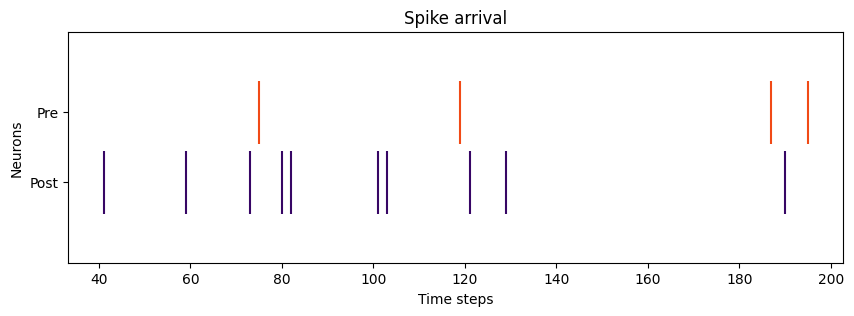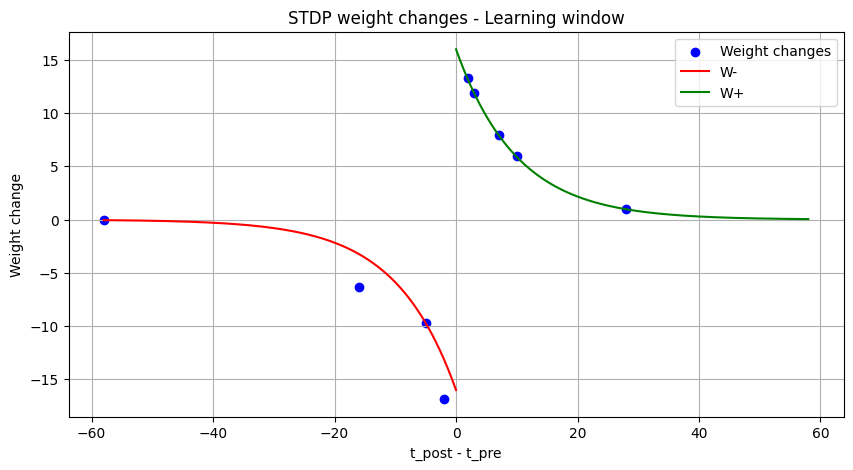Copyright (C) 2021 Intel Corporation SPDX-License-Identifier: BSD-3-Clause See: https://spdx.org/licenses/
Spike-timing Dependent Plasticity (STDP)
Motivation: In this tutorial, we will demonstrate usage of a software model of Loihi’s learning engine, exposed in Lava. This involves the LearningRule object for learning rule and other learning-related information encapsulation and the LearningDense Lava Process modelling learning-enabled connections.
This tutorial assumes that you:
have the Lava framework installed
are familiar with the Process concept in Lava
are familiar with the ProcessModel concept in Lava
are familiar with how to connect Lava Processes
This tutorial gives a bird’s-eye view of how to make use of the available learning rules in Lavas Process Library. For this purpose, we will create a network of LIF and Dense processes with one plastic connection and generate frozen patterns of activity. We can easily choose between a floating point simulation of the learning engine and a fixed point simulation, which approximates the behavior on the Loihi neuromorphic hardware. We also will create monitors to observe the behavior of the weights and activity traces of the neurons and learning rules.
STDP from Lavas Process Library
Let’s first generate the random, frozen input and define all parameters for the network.
Parameters
[130]:
import numpy as np
# Set this tag to "fixed_pt" or "floating_pt" to choose the corresponding models.
SELECT_TAG = "floating_pt"
# LIF parameters
if SELECT_TAG == "fixed_pt":
du = 4095
dv = 4095
elif SELECT_TAG == "floating_pt":
du = 1
dv = 1
vth = 240
# Number of neurons per layer
num_neurons = 1
shape_lif = (num_neurons, )
shape_conn = (num_neurons, num_neurons)
# Connection parameters
# SpikePattern -> LIF connection weight
wgt_inp = np.eye(num_neurons) * 250
# LIF -> LIF connection initial weight (learning-enabled)
wgt_plast_conn = np.full(shape_conn, 50)
# Number of simulation time steps
num_steps = 200
time = list(range(1, num_steps + 1))
# Spike times
spike_prob = 0.03
# Create spike rasters
np.random.seed(123)
spike_raster_pre = np.zeros((num_neurons, num_steps))
np.place(spike_raster_pre, np.random.rand(num_neurons, num_steps) < spike_prob, 1)
spike_raster_post = np.zeros((num_neurons, num_steps))
np.place(spike_raster_post, np.random.rand(num_neurons, num_steps) < spike_prob, 1)
Define STDP learning rule
Next, lets instatiate the STDP learning rule from the Lava Process Library. The STDPLoihi learning rule provides the parameters as described in Gerstner and al. 1996 (see also http://www.scholarpedia.org/article/Spike-timing_dependent_plasticity).
[131]:
from lava.proc.learning_rules.stdp_learning_rule import STDPLoihi
[132]:
stdp = STDPLoihi(learning_rate=1,
A_plus=1,
A_minus=-1,
tau_plus=10,
tau_minus=10,
t_epoch=4)
Create Network
The following diagram depics the Lava Process architecture used in this tutorial. It consists of: - 2 Constant pattern generators for injection spike trains to LIF neurons. - 2 LIF Processes representing pre- and post-synaptic Leaky Integrate-and-Fire neurons. - 1 Dense Process representing learning-enable connection between LIF neurons.
Note: All neuronal population (spike generator, LIF) are composed of only 1 neuron in this tutorial.
The plastic connection Process
We now instantiate our plastic Dense process. The Dense Process provides the following Vars and Ports relevant for plasticity:
Component |
Name |
Description |
|---|---|---|
InPort |
|
Receives spikes from post-synaptic neurons. |
Var |
|
Delay synaptic variable. |
|
Tag synaptic variable. |
|
|
State of x_0 dependency. |
|
|
Within-epoch spike times of pre-synaptic neurons. |
|
|
State of x_1 trace. |
|
|
State of x_2 trace. |
|
|
State of y_0 dependency. |
|
|
Within-epoch spike times of post-synaptic neurons. |
|
|
State of y_1 trace. |
|
|
State of y_2 trace. |
|
|
State of y_3 trace. |
[133]:
from lava.proc.lif.process import LIF
from lava.proc.io.source import RingBuffer
from lava.proc.dense.process import LearningDense, Dense
[134]:
# Create input devices
pattern_pre = RingBuffer(data=spike_raster_pre.astype(int))
pattern_post = RingBuffer(data=spike_raster_post.astype(int))
# Create input connectivity
conn_inp_pre = Dense(weights=wgt_inp)
conn_inp_post = Dense(weights=wgt_inp)
# Create pre-synaptic neurons
lif_pre = LIF(u=0,
v=0,
du=du,
dv=dv,
bias_mant=0,
bias_exp=0,
vth=vth,
shape=shape_lif,
name='lif_pre')
# Create plastic connection
plast_conn = LearningDense(weights=wgt_plast_conn,
learning_rule=stdp,
name='plastic_dense')
# Create post-synaptic neuron
lif_post = LIF(u=0,
v=0,
du=du,
dv=dv,
bias_mant=0,
bias_exp=0,
vth=vth,
shape=shape_lif,
name='lif_post')
# Connect network
pattern_pre.s_out.connect(conn_inp_pre.s_in)
conn_inp_pre.a_out.connect(lif_pre.a_in)
pattern_post.s_out.connect(conn_inp_post.s_in)
conn_inp_post.a_out.connect(lif_post.a_in)
lif_pre.s_out.connect(plast_conn.s_in)
plast_conn.a_out.connect(lif_post.a_in)
# Connect back-propagating action potential (BAP)
lif_post.s_out.connect(plast_conn.s_in_bap)
[135]:
from lava.proc.monitor.process import Monitor
[136]:
# Create monitors
mon_pre_trace = Monitor()
mon_post_trace = Monitor()
mon_pre_spikes = Monitor()
mon_post_spikes = Monitor()
mon_weight = Monitor()
# Connect monitors
mon_pre_trace.probe(plast_conn.x1, num_steps)
mon_post_trace.probe(plast_conn.y1, num_steps)
mon_pre_spikes.probe(lif_pre.s_out, num_steps)
mon_post_spikes.probe(lif_post.s_out, num_steps)
mon_weight.probe(plast_conn.weights, num_steps)
[137]:
from lava.magma.core.run_conditions import RunSteps
from lava.magma.core.run_configs import Loihi2SimCfg
[138]:
# Running
pattern_pre.run(condition=RunSteps(num_steps=num_steps), run_cfg=Loihi2SimCfg(select_tag=SELECT_TAG))
[139]:
# Get data from monitors
pre_trace = mon_pre_trace.get_data()['plastic_dense']['x1']
post_trace = mon_post_trace.get_data()['plastic_dense']['y1']
pre_spikes = mon_pre_spikes.get_data()['lif_pre']['s_out']
post_spikes = mon_post_spikes.get_data()['lif_post']['s_out']
weights = mon_weight.get_data()['plastic_dense']['weights'][:, :, 0]
[140]:
# Stopping
pattern_pre.stop()
Now, we can take a look at the results of the simulation.
[141]:
import matplotlib.pyplot as plt
Plot spike trains
[142]:
# Plotting pre- and post- spike arrival
def plot_spikes(spikes, legend, colors):
offsets = list(range(1, len(spikes) + 1))
plt.figure(figsize=(10, 3))
spikes_plot = plt.eventplot(positions=spikes,
lineoffsets=offsets,
linelength=0.9,
colors=colors)
plt.title("Spike arrival")
plt.xlabel("Time steps")
plt.ylabel("Neurons")
plt.yticks(ticks=offsets, labels=legend)
plt.show()
# Plot spikes
plot_spikes(spikes=[np.where(post_spikes[:, 0])[0], np.where(pre_spikes[:, 0])[0]],
legend=['Post', 'Pre'],
colors=['#370665', '#f14a16'])

Plot traces
[143]:
# Plotting trace dynamics
def plot_time_series(time, time_series, ylabel, title):
plt.figure(figsize=(10, 1))
plt.step(time, time_series)
plt.title(title)
plt.xlabel("Time steps")
plt.ylabel(ylabel)
plt.show()
# Plotting pre trace dynamics
plot_time_series(time=time, time_series=pre_trace, ylabel="Trace value", title="Pre trace")
# Plotting post trace dynamics
plot_time_series(time=time, time_series=post_trace, ylabel="Trace value", title="Post trace")
# Plotting weight dynamics
plot_time_series(time=time, time_series=weights, ylabel="Weight value", title="Weight dynamics")



Plot STDP learning window and weight changes
[144]:
def extract_stdp_weight_changes(time, spikes_pre, spikes_post, wgt):
# Compute the weight changes for every weight change event
w_diff = np.zeros(wgt.shape)
w_diff[1:] = np.diff(wgt)
w_diff_non_zero = np.where(w_diff != 0)
dw = w_diff[w_diff_non_zero].tolist()
# Find the absolute time of every weight change event
time = np.array(time)
t_non_zero = time[w_diff_non_zero]
# Compute the difference between post and pre synaptic spike time for every weight change event
spikes_pre = np.array(spikes_pre)
spikes_post = np.array(spikes_post)
dt = []
for i in range(0, len(dw)):
time_stamp = t_non_zero[i]
t_post = (spikes_post[np.where(spikes_post <= time_stamp)])[-1]
t_pre = (spikes_pre[np.where(spikes_pre <= time_stamp)])[-1]
dt.append(t_post-t_pre)
return np.array(dt), np.array(dw)
def plot_stdp(time, spikes_pre, spikes_post, wgt,
on_pre_stdp, y1_impulse, y1_tau,
on_post_stdp, x1_impulse, x1_tau):
# Derive weight changes as a function of time differences
diff_t, diff_w = extract_stdp_weight_changes(time, spikes_pre, spikes_post, wgt)
# Derive learning rule coefficients
on_pre_stdp = eval(str(on_pre_stdp).replace("^", "**"))
a_neg = on_pre_stdp * y1_impulse
on_post_stdp = eval(str(on_post_stdp).replace("^", "**"))
a_pos = on_post_stdp * x1_impulse
# Derive x-axis limit (absolute value)
max_abs_dt = np.maximum(np.abs(np.max(diff_t)), np.abs(np.min(diff_t)))
# Derive x-axis for learning window computation (negative part)
x_neg = np.linspace(-max_abs_dt, 0, 1000)
# Derive learning window (negative part)
w_neg = a_neg * np.exp(x_neg / y1_tau)
# Derive x-axis for learning window computation (positive part)
x_pos = np.linspace(0, max_abs_dt, 1000)
# Derive learning window (positive part)
w_pos = a_pos * np.exp(- x_pos / x1_tau)
plt.figure(figsize=(10, 5))
plt.scatter(diff_t, diff_w, label="Weight changes", color="b")
plt.plot(x_neg, w_neg, label="W-", color="r")
plt.plot(x_pos, w_pos, label="W+", color="g")
plt.title("STDP weight changes - Learning window")
plt.xlabel('t_post - t_pre')
plt.ylabel('Weight change')
plt.legend()
plt.grid()
plt.show()
# Plot STDP window
plot_stdp(time, np.where(pre_spikes[:, 0]), np.where(post_spikes[:, 0]), weights[:, 0],
stdp.A_minus, stdp.y1_impulse, stdp.tau_minus,
stdp.A_plus, stdp.x1_impulse, stdp.tau_plus)

As can be seen, the actual weight changes follow the defined STDP with a certain amout of noise. If the tag is set to fixed_pt, the weight changes get more quantized, but still follow the correct trend.
